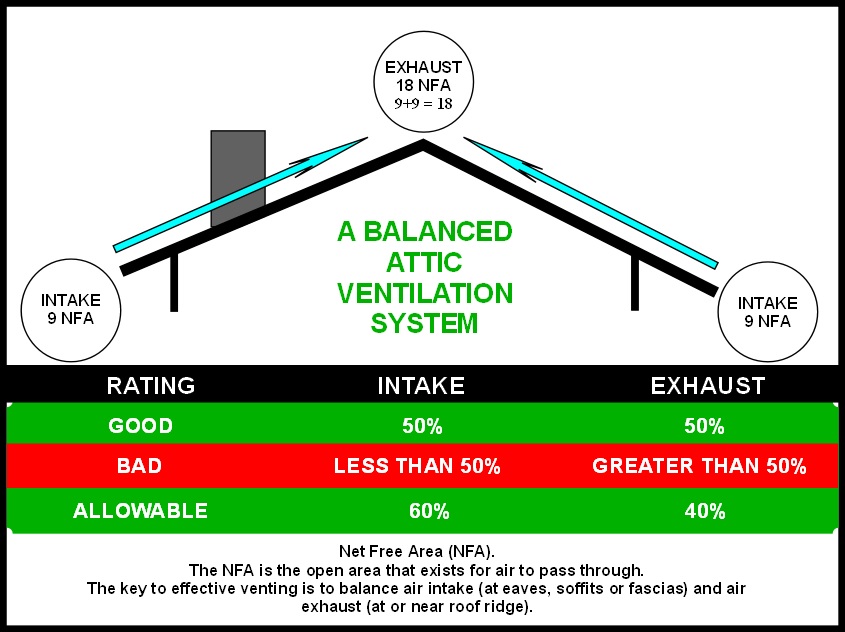Why should you care about attic ventilation? 93% of houses in the South are not ventilated for proper air flow. Proper air flow extends the life of your roof, prevents damage to the inside of your home, minimizes repairs, and lowers cooling bills. It also reduces the potential for mold in the attic space, aging of the roof, warping of the roof deck, and curling of asphalt shingles. Understanding how air flow in a confined area works helps people achieve better ventilation and improve the life of their roof.
Too Much Hot Air
Attic ventilation works off the basic principal that hot air rises. Intake vents are needed at or near the bottom of the attic. Hot air exhaust vents are needed at the top, the closer to the ridge the better. The minimum amount of attic ventilation is 1:150 sf; for every 150 square feet of attic flooring, there should be at least 1 square foot of Net Free Area. Under special conditions required venting may be as little as 1:300 sf.
A Balanced Life
Despite Texan’s motto that “bigger is always better,” too much exhaust venting can cause problems as well. There should be a 50-50 balance between the intake of fresh air at the bottom and the outlet of hot, stale air at the top. Ventilation should be balanced on each side and between the front and back also. Many well-meaning contractors advise putting turbine vents on the back to increase the curb appeal of a house. But this violates the principal of balanced air flow. When there is an imbalance of air flow with too much exhaust, it will draw from the next closest or easiest area. This may be from leaks in air conditioning, from the interior of the home, or from other exhaust vents. If it pulls from the conditioned space, moisture may build up and can cause mold. If it pulls from another exhaust vent, it will return hot, stale air to the attic.
Breathe Easy
Soffit venting and On-Roof venting are types of intake vents. Soffit venting can be a continuous vent along the underside of the roof edge or can be referred to as “bird blocking” which often does not provide enough ventilation. Common problems with soffit venting are blockage by attic insulation and paint, or not enough net free area originally. On-Roof vents are cut into the roof decking in the bottom third. These are specialized vents that are properly flashed and do not disturb the curb appeal.
There are several types of exhaust vents: powered fan vents, static vents, gable vents, and ridge vents. Powered fan vents suck out the air when the attic reaches a preset temperature. Power vents have two main problems. First, they are powerful enough to pull A/C from the interior. Second, they don’t usually have a long life expectancy and stop working altogether. Static vents are placed near the top on the roof and simply exhaust the hot air naturally. Gable vents which used to be so popular are no longer considered the best option. Ridge vents are the best because they exhaust air in a continuous line along the highest part of the roof naturally. However, with today’s fancy roof lines, there is not usually enough area to ventilate through the ridge line alone.
In The Zone
Know where your attic zones are located. A home may have a continuous attic space or there might be several separate areas. Complicated roofing structures, vaulted or cathedral ceilings, and renovated attic living space change the calculations needed for ventilation. For example fire walls divide the space and cathedral ceilings leave very little space between the roof and interior. When each isolated zone is calculated for balanced air flow, the house and roof benefit.
Covered and Cool
It’s always a good idea to check with an energy specialist or make certain your roofers are certified to install the specific brand of roofing you have chosen. Most of the larger roof material companies have ventilation instructions printed on the bundles of shingles. Plus, roofing material warranties require proper attic ventilation since improper ventilation bakes the asphalt material, causes cracking, curling, and premature aging of the roof covering and the sheathing underneath. By contrast, proper air flow extends the life of the house and makes your living better. There’s no reason why 93% of people should not enjoy better cooling bills and better roofs with proper ventilation.
Marcella Lohmann is a licensed home inspector who enjoys working with her husband John. Much of the information for this blog entry is attributable to SPEER (South-central Partnership for Energy Efficiency as a Resource) and a webinar by Quarrix titled, Clearing the Air: Case Studies in Roof and Attic Ventilation in Residential and Multifamily Projects.

